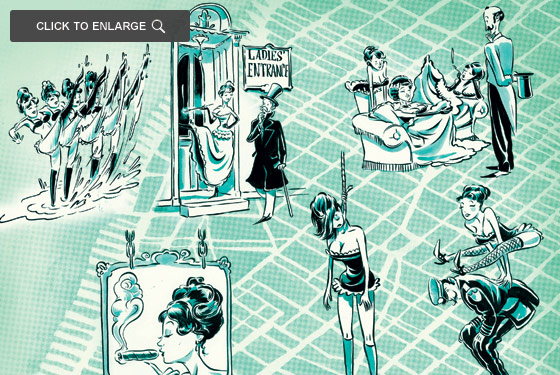
Map by Richard Zacks, Sarah Ruddy, and Jen Cotton
Illustration by Zohar Lazar
Attempts to rid New York of misbehavior did not start with Mayors Rudy and Mike. Nor is Anna Gristina, the tabloids’ latest headline generator, anything new. Richard Zacks’s Island of Vice: Theodore Roosevelt’s Doomed Quest to Clean Up Sin-Loving New York (Doubleday) makes it clear that, at the end of the nineteenth century, New York was much more wicked than it is today and even harder to sanitize. There was not one principal red-light district; there were three. What is now the NYU campus, especially around West 3rd and Greene Streets, was a vast bazaar where prostitutes offered the then-taboo pleasure of oral sex. (“How do you want it? French or American?” was the standard question. The price: $2.) Even more cheap brothels filled the Lower East Side, institutions known for foul odors, foreign-born women, and 50-cent services. (That was half a day’s wages for many workingmen.) And then there was the Tenderloin, the two-block-wide swath flanking Broadway from 23rd to 42nd Street. There, dance houses, casinos, and posher brothels operated openly, kept in business by bribes and a general shrug of tolerance. Theodore Roosevelt, during his term as police commissioner from 1895 to 1897, tried hard to crack down, but the brothels did just fine. (Really, the only thing that shrank the sex trade was, as the madams put it, “amateur competition”: the wide acceptance of premarital sex.) Click on the above map to explore Zacks’s full list, read his guide to the most notorious downtown spots, and see whether your home was once a very different kind of house.